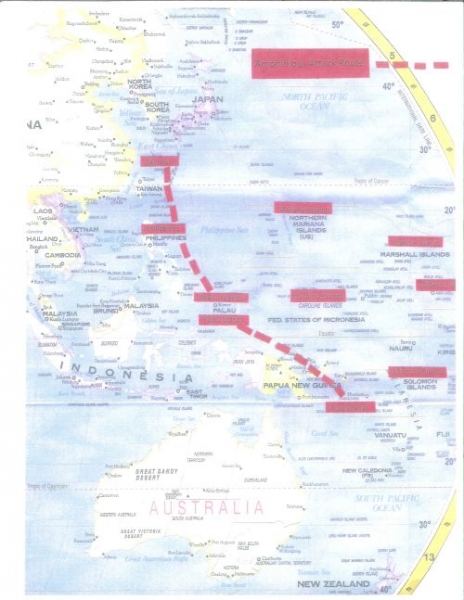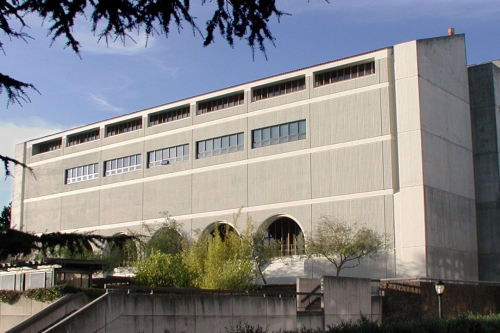CEE Professor Emeritus Jerome Thomas has been recognized for his four years of service in World War II.
Thomas served as a Lieutenant in the United States Naval Reserve as a Qualified Deck Engineer. He traveled the South Pacific continuously for 15 months aboard the LST 991 "The Lady Bug".
See below:
After the capture of Okinawa and the declaration of peace, Thomas received orders home to Berkeley. He received his PhD in physical and organic chemistry and joined the CEE faculty in 1955. Thomas taught applied chemistry to civil engineers until he retired in 1987.
Thomas, a skilled woodcarver, and his seminar class in "Wood Sculpting and Related Art" carved CEE's Oski the Bear.
The class gifted the bear to the department in 2000. Oski stands in the 7th floor lobby of Davis Hall to this day. During the holidays, he gets an elf hat.
During Thomas's recent visit to Davis Hall, we snapped a photo of the artist with his work.
LST 991's route through the South Pacific

(Red marks battle landings in the "leap frog" operation made by LST 991.)
Thomas's account of his service aboard the LST 991
- Traveled South Pacific continuously in convoy for approximately 15 months as engineering officer aboard LST 991.
- LST stands for landing ships for tanks (tanks used in Atlantic European landing but not in South Pacific landing). LST better described as amphibious attack transport traveling in South Pacific including the Marianas, Marshal, Carolina, Solomon, Philippines and Gilbert Islands.
- Ship personnel: 125 men—10 officers. Of the 125 men, 33 men in the “black gang” (the engineering work force). In addition, for attack landing operations, ships carried approximately 350 fighting personnel (Marines and Army) and their equipment.
- LST 991—length approximately 325 feet—width approximately 60 feet; with bow doors that opened with access ramp to and from the upper and lower deck for beaching operations. The ship is flat bottom with no keel which allowed driving the ship directly onto the beach. (A very difficult and dangerous operation, both landing and retracting, because of Japanese strafing and bombing planes.)
- LST 991 participated in 5 attack battle landings in a “leap frog” operation from island to island heading to the ultimate capture of Japan. LST 991 received 5 citations from the US government for attack battle landings. In addition, 2 citations were received from the Philippine government for attack battle landing in the liberation of the Philippines. After retraction from the attack battle landings injured personnel were picked up and carried by reforming convoys to secured hospital and supply areas.
- When not participating in attack landing operations the LSTs were continuously used as transport vessel carrying replacement personnel and supplies, always in convoy to secured forward ships and bases.
- Underway the ships traveled in convoy with protection provided by destroyers and destroyer escorts; convoy operations were a constant hazard day and night by submarines (German and Japanese) and Japanese planes (torpedo, bombing and strafing).

